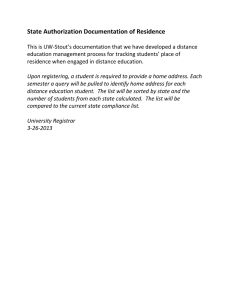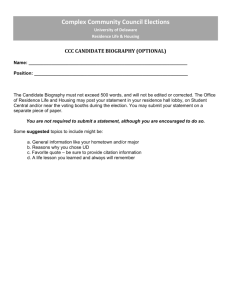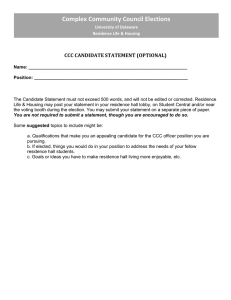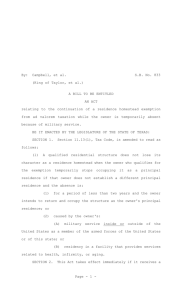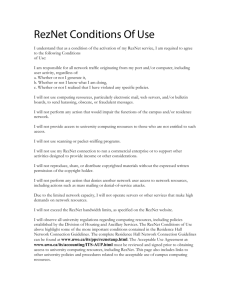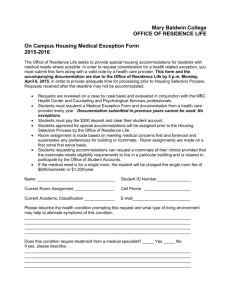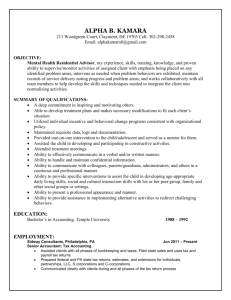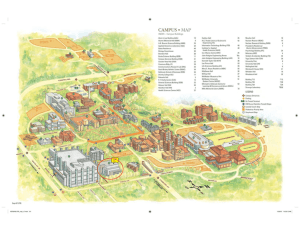F04 Residence Hall House Feedback Survey Report Iowa State University
advertisement
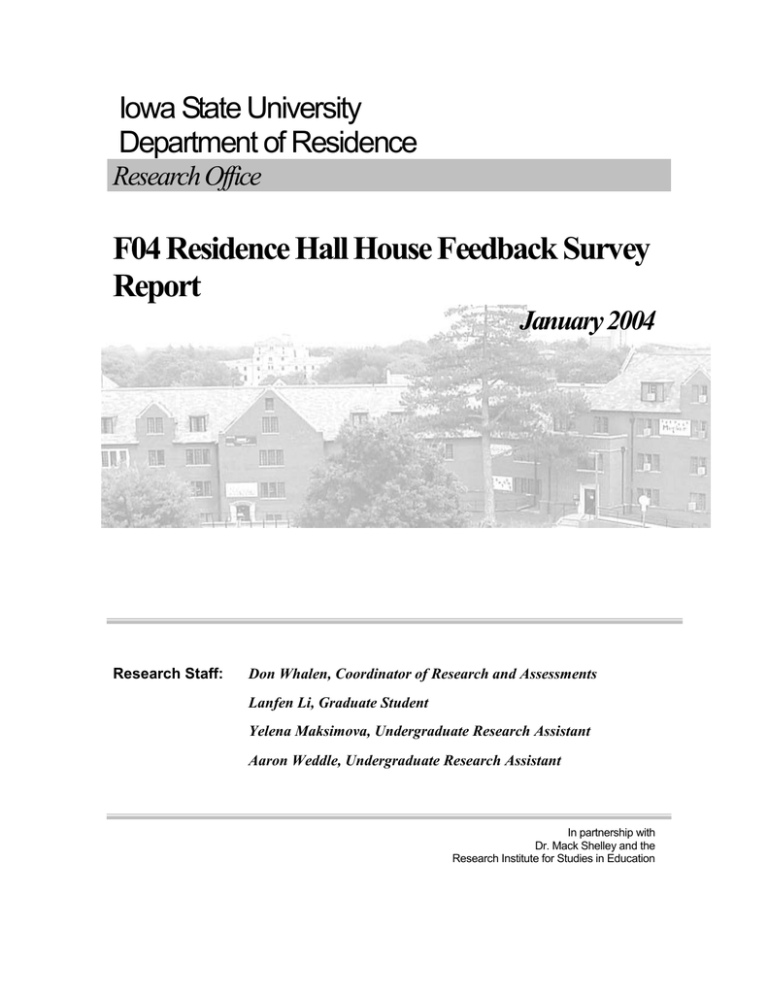
Iowa State University Department of Residence Research Office F04 Residence Hall House Feedback Survey Report January 2004 Research Staff: Don Whalen, Coordinator of Research and Assessments Lanfen Li, Graduate Student Yelena Maksimova, Undergraduate Research Assistant Aaron Weddle, Undergraduate Research Assistant In partnership with Dr. Mack Shelley and the Research Institute for Studies in Education Fall 2004 Residence Hall House Feedback Summary Abstract This summary of responses (N = 2,681) to residence hall survey showed evidence that residents are very satisfied with their Community Advisor (CA) and the general atmosphere of their house. They were moderately satisfied with their house government, and their communication with upper-level hall staff members (Hall Directors, Assistant Hall Directors). Most items reflected an improvement, and only two items showed a decline from Fall 2003. Introduction The House Feedback survey was conducted for the tenth consecutive year to provide information about resident attitudes toward their Community Advisors (CAs), house cabinet, Hall Director, and their house atmosphere. Fall 2004 results, including 6 qualitative questions, were previously compiled by hall and house in the F04 House Feedback Hall/House report to provide resident feedback for use by the Hall Director in evaluating CAs. This report provides a general analysis of all the House Feedback Surveys. Method The House Feedback survey was administered as a web survey. An e-mail cover letter was sent to every residence hall student (N=5,478) providing the electronic address for the survey. The survey included a core group of 36 questions, six of which were open-ended response questions. In addition the survey included an additional questions from four other focus areas: (a) leadership quality (b) hall desk quality (c) quality of life-residence life, and (d) quality of custodialmaintenance. The entire survey did not exceed 85 questions, regardless of which group of additional questions were included. This report focuses solely on the 36 house feedback questions. A report for each of the additional question groups will be presented in separate reports. Most house feedback questions used a Likert-type response scale that reflected the following scale, after recoding: (1 = Strongly disagree; 2 = Disagree; 3 = No opinion; 4 = Agree; and 5= Strongly agree). Overall response to the survey (2,681/5,478) was 49%; however, only 2,573 of the surveys were usable. The response rate was partially due to an award of an incentive of a pizza party competition that was promised to the two or three houses in each residence neighborhoods with the highest proportion of surveys returned. Results For returned surveys, the majority of respondents were female (48.9%), non-Hispanic White (91.5%), Fresh-start student (50.7%) and freshman (61.8%). The tables at the end of the executive summary show the findings of the survey. Table 1: Response frequencies in question order Table 2: Mean comparisons by gender. Table 3: Mean comparisons by minority status. Table 4: Mean comparisons by Fresh Start status. Table 5: Mean comparisons by classification. Table 6: Historical comparisons Overall satisfaction (Table 1) CA. Residents indicated satisfaction with many aspects of their house. Residents’ satisfaction with their CA was scored high on most questions. The highest rated individual question within the CA question grouping indicated residents perceived the CA to follow rules and regulations (4.47). Residents gave the lowest rating to the ability of the CA to direct them for academic help low (3.73). Hall Director (HD)/Assistant Hall Director (AHD). The rating for these questions measure students’ knowledge of their HD/AHD. Just under half (49%) knew either their HD (37%), AHD (1%), or both (10%). A majority (61%) knew how to reach their HD (37%), AHD (1%), or both (23%). Not surprisingly, the responses indicate that most students would know their AHD only if they also knew their HD. House cabinet. Ratings for house cabinet questions were generally good, but not very good. Respondents were most in agreement that their cabinet considers the entire house when planning activities (3.88) and that house meetings are run effectively (3.87). There was less agreement that the cabinet members built house community effectively (3.77). House atmosphere. An important rating item received 88% agreement, the students’ comfort living in their house (M=4.40). Most students (89%) said they were satisfied with their overall residence hall experience (M=4.13). In addition, most (89%) felt they were able to study in the residence halls when they chose to do so (M=4.14). Historical Comparisons Mean responses for the survey were compared with those from the previous fall. Responses were generally higher. There were ten questions in which mean ratings increased .10 or more. The exceptionally high responses with at least a .15 increase from last fall were CA availability in the house (4.06 in F03; 4.21 in F04), CA directing residents for help about academic concerns (3.57 in F03; 3.73 in F04). Only two items received a decrease in ratings by students: Satisfaction relationship with roommate(s) (4.11 in F03; 3.99 in F04), and a feeling that the Hall Director knew them (2.65 in F03; 2.56 in F04). Demographic comparisons (Tables 2-6) Gender. On the agreement scale, men said they knew more people in the house (M = 3.72) than did women (M = 3.38) (Table 2). Men were also more likely to feel a stronger feeling of respect for other’s individuality and beliefs exists in their house (M = 4.00) than were women (M = 3.86). Women (M = 4.36) agreed more than men (M = 4.26) that the CA enforced policies in an appropriate manner. Classification. As indicated in Table 3, freshmen (M = 4.18) believed more than seniors (M = 3.99), juniors (M = 4.07), and sophomores (M = 4.08) that the CA worked well with the cabinet. Sophomores (M = 4.20) indicated more satisfaction with their relationship with their roommate than freshmen (M = 3.92), seniors (M = 4.00), and juniors (M = 4.07). Juniors (M = 4.25) believed more than sophomores (M = 4.19), freshmen (M = 4.08), and seniors (M = 4.20) that they were more satisfied with their overall residence hall experience. Seniors (M = 2.91) believed more than juniors (M = 2.82), sophomores (M = 2.61), and freshmen (M = 2.47) that their CA knows who they are. Minority status. As indicated in Table 4, only two significant differences were found between minority and majority responses. More minority students (M = 2.93) felt the HD/AHD knew them than did majority students (M = 2.53). Minority students also agreed (M = 3.97) more than majority students (M = 3.82) that they took advantage of opportunities to learn about people whose backgrounds/beliefs that are different from their own. Fresh Start status. As indicated in Table 5, students living in Fresh Start buildings believed (M = 4.24) that they were able to study in the residence halls if and when they chose than students in other buildings (M = 4.04). More Fresh Starters also believed (M = 3.84) that cabinet members were effective at building community in the house more than non-Fresh Starters (M = 3.71). More non-Fresh Starters believed (M = 4.15) that their CA tried to get to know residents than Fresh Starters (M = 4.03). More non-Fresh Starters believed (M = 3.60) that they knew most of the people in their house (M = 3.49). Historical comparisons. Table 6 compares responses for the past two years (Fall 2002 and Fall 2003) as well as the earliest fall survey (Fall 1997). Because of changes in surveying, particularly a shortening of this year’s survey, comparisons for all questions are not available. For 18 questions that were the same for Fall 2003 and Fall 2004, 16 of the 18 items showed an improvement. Items with the greatest change from the previous year were the CA’s ability to direct students for academic assistance (mean increase of .16), CA availability in the house (mean increase of .15), comfort approaching the CA (mean increase of .14), and CA consistency in enforcement of policies (mean increase of .14). Conclusions Responses to the house feedback survey were overall very positive. Two important ratings in particular received high marks: the student’s comfort living in their residence hall house, and the students’ overall satisfaction with the residence halls. Benchmark comparisons from the previous year demonstrated that previous fall comparisons, even those as early as Fall 1997, indicated an increase in most mean ratings. The RA/CA’s ability to direct students for academic help did not receive a high mean rating, and when compared with Fall 1997, a time when many academic initiatives were put in place, the mean rating has actually decreased slightly. Given the departmental focus on academic support, an effort should be made to increase this rating. CAs are trained to be academic resources, and they should share the information liberally. While the rating CAs being a good source for academic assistant is lower than other CA ratings, it might be due to a difference in what students expect of the CA and what the CA provides. More information should be collected through house discussions or focus groups to determine what students expect of CAs in terms of academic support. There was some decline in students’ satisfaction with their roommate. Residence life staff could focus on roommate programs such as how to get along, and increasing communication between roommates. The CA can also try to be more intrusive in resolving roommate conflicts, when appropriate.
